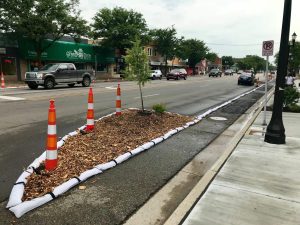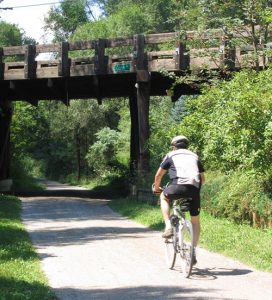I went for a bike ride today. It was chilly but sunny so I bundled up and jumped on. I zipped through my city streets, onto the campus of Michigan State University, and finally out on the country roads south of campus. It’s a ride I’ve done dozens of times, but on this day I was keenly aware of how peaceful and SAFE I felt on the roads. Few cars passed me (and none honked at me as though I’m a leper), and I could hear birds and frogs. This is bike riding in the time of pandemic. Stay-at-home orders mean substantially less car traffic on my route.
I’m lucky to live close enough to my work that I can ride there in warmer weather. For my commute, I traverse through neighborhoods and along major road corridors—in bike lanes where they are available or amongst traffic when they are not. The fresh air and bit of exercise always makes me feel better and more productive for the day. I know that the experience benefits my mental and physical health, and its certainly better for the environment in my community.
But the daily ride can be precarious sometimes. When we hear about “fixing the damn roads” it’s always about the impacts on car travel. But cyclists suffer the effects of poor transportation infrastructure as well. Potholes and debris on the shoulders or in bike lanes can flatten tires or send us flying over handlebars. And most cyclists I know have regular encounters with vehicles that put their safety at risk. This is exacerbated when infrastructure like bike lanes is non-existent.
Like me, I’m sure many of you have watched as people have flocked outside during this COVID-19 shutdown. Pedestrians, skateboarders, bikers, and scooter-riders are using our communities’ streets, sidewalks, and trails like never before—to grab take out at their favorite restaurants, get exercise, or just be outside. In order to maintain social distancing, they have taken over streets—walking and riding (gasp) right in the middle of the road.

What we can observe from this pandemic is that when safe and inviting non-motorized transportation infrastructure is available, people will take advantage. Will many of these people go back to their cars when this is all over? Sure. But this moment in time has helped show us how enjoyable it can be to go from point A to B on our feet or two wheels (or one wheel if you’re really adventurous). Maybe it has permanently shifted some people’s priorities as they’ve realized it’s easier to say “hi, I hope you’re well” when walking or riding past folks than from behind the wheel and windows of our automobiles.
How will we use this experience to adjust our infrastructure planning? There are certainly longer-term and capital-intensive solutions that we should be adopting—road diets, added bike lanes, new and wider sidewalks in our neighborhoods, or more trail connections in our regions. These are critical community assets that improve quality of life and help build community wealth.
But there are easier and more temporary options as well. Hasn’t this experience showed us that we have roads that are underutilized—at least some of the time—that could be mixed use? What if some of our communities’ streets were closed to car traffic some of the time to allow pedestrians and bikes to move more freely and safely? What if we experimented with adding temporary bike lanes on some roads just by using paint or traffic cones and then monitored what happened with cars, bikes, and pedestrians on those areas? Some of our Michigan communities, like Lansing, have taken over parking spaces in their downtowns and made them temporary bike and pedestrian corridors with great success.
We’ve learned that there is interest and benefits to our communities in having better quality, safer spaces for people instead of cars. Let’s make this our new normal.
